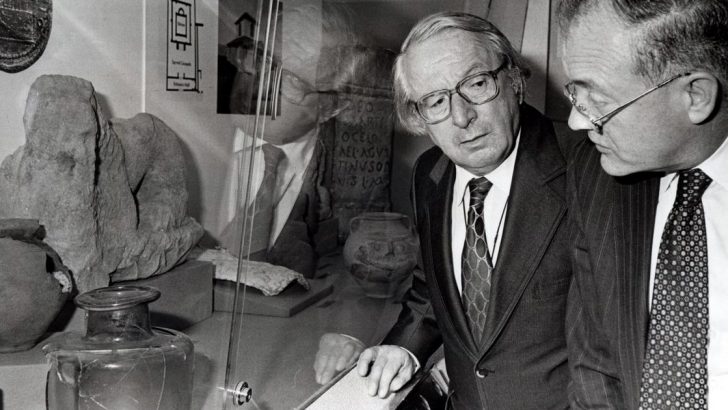The World of Books
The notion that the Apostle of Ireland was also the country’s first archaeologist is not, I should hasten to admit, an aberration of my own.
It was the idea of my late friend Glyn Daniel [pictured], Professor of Archaeology at Cambridge. When the very suggestive evidence is laid out the claim may not seem quite so strange and outlandish, for it also reveals something of the way in which Early Christian Ireland related to the country’s long pagan past.
Prof. Daniel was a world authority on European megaliths. In the course of a Walter Neurath Lecture on ‘Megaliths in History’ (privately published in 1972 for the Neurath family by Thames and Hudson), he discussed some of the curious stories from early Christian legends recorded in medieval Irish manuscripts. This passage is from the 9th Century Vita Tripartita Sancti Patricii (translated by Dr James Carney).
“And Patrick came to Duchuil to a great grave, of astounding breath and prodigious length which his familia had found. And with great amazement they marvelled that it extended 120 feet, and they said, ‘we do not believe this affair, that there was a man of this length’. And Patrick answered and said, ‘if you wish you shall see him’, and they said ‘we do.’
“And he struck with his crozier a stone near its head, and signed the grave with the sign of the cross, and said ‘Open, O Lord, the grave’. And the holy man opened the earth and the giant arose whole and said: ‘Blessed be you, O holy man, for you have raised me even for one hour from many pains.’
“ Speaking so, he wept most bitterly, and said, ‘I will walk with you.’ They said, ‘We cannot allow you to walk with us, for men cannot look upon your face from fear of you. But believe in the God of Heaven and accept the baptism of the Lord, and you shall return to the place in which you were. And tell us of whom you are.’
“ [And the man said] ‘I am the son of the son of Cas, son of Glas, and was swineherd to King Lugar, king of Hirota. The warrior-band of the son of Mac Con slew me in the reign of Coirpe Nioth Fer, 100 years ago today.’
“And he was baptised and confessed God, and he fell silent, and was placed once more in his grave.”
It was O. G. S. Crawford, writing in Antiquity back in 1936, who first drew the attention of archaeologists to this remarkable passage. He had no doubt what it meant: “It is not generally known’, he wrote, “that the first recorded opening of a Long Barrow was carried out by St Patrick”.’ Paul Ashbee, writing in 1969, supported this interpretation.
Glyn Daniel did not accept the view that Patrick was dealing with a long barrow, but thought the saint was exploring some old, and possibly megalithic tomb.
Daniel talked over this question of the contacts of Patrick with the pagan past of Ireland with Dr Kathleen Hughes, a well-known specialist in the field.
She pointed out that raisings from the dead are a common hagiographical theme, but she also thought that some beliefs current in Ireland at that time went back to the megalithic age.
Studies
From her own studies she was convinced that the ancient sites were not merely taken over for Christian use, but with them also came the lands that supported the old Druid colleges. The rentals now went to support the new churches.
This paganism both Crawford and Daniel surmised was not Druidic. Seán O’Riordain, who excavated Tara, and died sadly young, held that at the time of St Patrick there was a mere veneer of lordly Celtic-speaking chieftains, craftsmen and poets. But that the Irish population were basically the same as the “people of the Neolithic and Early Bronze Age who built the great megalithic tombs”.
And it was with the rites and rituals and the ancient heroes of these people that Patrick had some sort of contact.
This is the sort of puzzle that makes one regret the tremendous losses of medieval manuscripts in which so much ancient lore was recorded.
We simply don’t know the half of it.


 Peter Costello
Peter Costello Glyn Daniel
Glyn Daniel 